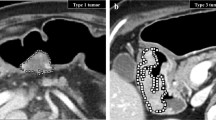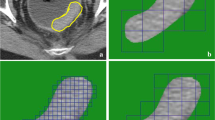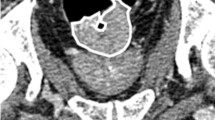Abstract
Purpose
The purpose of this study is to assess the heterogeneity of tumor enhancement using fractal analysis on contrast-enhanced computed tomography (CE-CT) for predicting malignant potential of gastrointestinal stromal tumor (GIST).
Methods
We retrospectively identified 64 patients (36 M/28 W; median age: 65) with GISTs who received CE-CT and 18F-fluorodeoxyglucose positron emission tomography (FDG-PET) followed by curative surgery. Fractal analysis was applied to CE-CT image, and fractal dimension (FD) was measured. Diagnostic value of FD for malignant potential of GIST was compared with that of FDG-PET using the risk classification and Ki67 index.
Results
14 patients were categorized as the high risk, and 50 patients were as the very low, low or intermediate risk. FD of high-risk group was significantly higher than that of the other-risk group (p < 0.05). The areas under the ROC curves of FD and SUVmax for prediction of high-risk group were 0.82 and 0.93 (accuracy: 84.4% and 98.5%). FD showed a significant positive correlation with Ki67 index (p = 0.01).
Conclusion
Diagnostic value of CT fractal analysis for prediction of high-risk GIST is comparable with FDG-PET. In terms of cost and availability, fractal analysis has a potential to be an optimal preoperative biomarker.




Similar content being viewed by others
References
Kamiyama Y, Aihara R, Nakabayashi T, et al. (2005) 18F-Fluorodeoxyglucose positron emission tomography: useful technique for predicting malignant potential of gastrointestinal stromal tumors. World J Surg 29:1429–1435
Hirota S, Isozaki K, Moriyama Y, et al. (1998) Gain-of-function mutations of c-kit in human gastrointestinal stromal tumors. Science 279:577–580
Miettinen M, Sobin LH, Sarlomo-Rikala M (2000) Immunohistochemical spectrum of GISTs at different sites and their differential diagnosis with reference to CD117 (KIT). Mod Pathol 13:1134–1142
Japan Society of Clinical Oncology, Japanese Gastric Cancer Association, Japanese Study Group on GIST (2014) Japanese clinical practice guidelines for gastrointestinal stromal tumors (GIST), 3rd edn. Japan: Kanehara
Fletcher CD, Berman JJ, Corless C, et al. (2002) Diagnosis of gastrointestinal stromal tumors: a consensus approach. Hum Pathol 33:459–465
Miettinen M, Lasota J (2006) Gastrointestinal stromal tumors: pathology and prognosis at different sites. Semin Diag Pathol 23:70–83
Joensuu H (2008) Risk stratification of patients diagnosed with gastrointestinal stromal tumor. Hum Pathol 39:1411–1419
Basilio-de-Oliveira RP, Pannain VL (2015) Prognostic angiogenic markers (endoglin, VEGF, CD31) and tumor cell proliferation (Ki67) for gastrointestinal stromal tumors. World J Gastroenterol 21:6924–6930
Park JW, Cho CH, Jeong DS, Chae HD (2011) Role of 18F-fluoro-2-deoxyglucose positron emission tomography in gastric GIST: predicting malignant potential pre-operatively. J Gastric Cancer 11:173–179
Yoshikawa K, Shimada M, Kurita N, et al. (2013) Efficacy of PET-CT for predicting the malignant potential of gastrointestinal stromal tumors. Surg Today 43:1162–1167
Tokumoto N, Tanabe K, Misuimi T, et al. (2014) The usefulness of preoperative 18FDG positron-emission tomography and computed tomography for predicting the malignant potential of gastrointestinal stromal tumors. Dig Surg 31:79–86
Wong CS, Gong N, Chu YC, et al. (2012) Correlation of measurements from diffusion weighted MR imaging and FDG PET/CT in GIST patients: ADC versus SUV. Eur J Radiol 81:2122–2126
Hayano K, Yoshida H, Zhu AX, Sahani DV (2014) Fractal analysis of contrast-enhanced CT images to predict survival of patients with hepatocellular carcinoma treated with sumitinib. Dig Dis Sci 59:1996–2003
Hayano K, Lee SH, Yoshida H, et al. (2014) Fractal analysis of CT perfusion images for evaluation of antiangiogenic treatment and survival in hepatocellular carcinoma. Acad Radiol 21:654–660
Marushina MY, Mochalina AP, Frolova EP, et al. (2017) MRI image processing based on fractal analysis. Asian Pac J Cancer 18:51–55
Turmer NC, Reis-Filho JS (2012) Genetic heterogeneity and cancer drug resistance. Lancet Oncol 13:178–185
Gerlinger M, Rowan AJ, Horswell S, et al. (2012) Intratumor heterogeneity and branched evolution revealed by multiregion sequencing. N Engl J Med 366:883–892
Kanda Y (2013) Investigation of the freely available easy-to-use software ‘EZR’ for medical statistics. Bone Marrow Transplant 48:452–458
Author information
Authors and Affiliations
Corresponding author
Ethics declarations
Conflict of interest
The authors declare that they have no conflict of interest.
Ethical approval
This retrospective study was approved by the institutional review board at our institute. Written informed consent for participation was not required because of the retrospective nature of this study; however, all patients gave their written informed consent to undergo CE-CT and FDG-PET examinations.
Informed consent
Informed consent for this study was waved by the hospital’s medical ethics committee as all patients underwent CT, MRI and FDG-PET as part of their clinical work-up.
Rights and permissions
About this article
Cite this article
Kurata, Y., Hayano, K., Ohira, G. et al. Fractal analysis of contrast-enhanced CT images for preoperative prediction of malignant potential of gastrointestinal stromal tumor. Abdom Radiol 43, 2659–2664 (2018). https://doi.org/10.1007/s00261-018-1526-z
Published:
Issue Date:
DOI: https://doi.org/10.1007/s00261-018-1526-z




